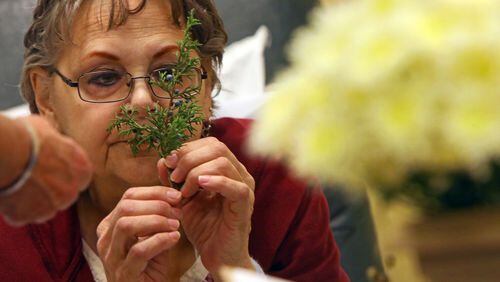ST. LOUIS — Half-reclined and wrapped in a shawl, Lauren Underhill spins a sprig of red-blossomed pineapple sage with her left thumb and index finger.
Under the shawl, a catheter tube connects to a vein infusing her bloodstream with a cocktail of anti-cancer drugs. Underhill, who has stage 4 colon cancer, spends up to five hours at the Siteman Cancer Center south of St. Louis during such appointments, waiting in repose.
Underhill turns her attention to her right, where Missouri Botanical Garden therapeutic horticulture instructor Jeanne Carbone holds a piece of rue — an herb, Carbone says, that likes a lot of sunshine and little attention.
“Oh, that’s like me,” Underhill says, reaching for it. “That’s my kind of plant.”
The Botanical Garden’s therapeutic horticulture program has grown in popularity in recent years, offering connections with nature to those enduring serious illness, developmental disabilities, or physical or mental trauma. It includes sessions at the garden, in a part known as the Sensory Garden, as well as outreach at area treatment centers such as Siteman.
“We believe that connection to nature provides healing,” Carbone said. “I can bring this to people who are probably in the worst situation they’re ever going to be in.”
Thomas Brouk, 68, has received regular anti-cancer drug infusions since January to treat his lymphoma. Brouk, who grew up on a farm in Arnold, said he didn’t have electricity until 1978 and had always had a special connection with plant life, roses in particular.
Brouk had Carbone make a little flower display of mums ringed by green herbs. He’ll be in the treatment pod for a few more hours, but in that moment he’s focused on where he’ll put the flowers, on a wood bench in his living room that gets sun in the morning.
“It brings a little joy to a place like this,” Brouk said. “It’s so nice to see the different flowers, what God has given us.”
Some other locations where the Botanical Garden offers therapeutic horticulture include Ranken Jordan Pediatric Hospital, Hope Lodge and Crisis Nursery. At the Sensory Garden, visitors are treated to scented flowers, spicy herbs, the sounds of a bell tree and fountain, and plants with unique textures including annuals and perennials.
Susan Bussen, a liver cancer patient, said such activities helped her pass the time during treatments, which “last long enough to have doughnuts and gossip” with friends who have joined her. Bussen said she had always grown herbs at home, and Carbone’s rue plant reminded her of one she used to have outside her front door.
“I read that rue keeps evil spirits away,” Bussen said. “I used to joke I put it there to keep my sisters out.”
The American Horticultural Therapy Association website says the benefits “have been documented since ancient times,” and in modern times the practice has gained acceptance among medical professionals. In the 1940s and 1950s, medical care providers increasingly used garden environments for therapy with returning U.S. war veterans, and the practice continued growing from there.
Botanical Garden representatives say therapeutic horticulture is for everyone, not just those with specific needs. For cancer patients such as Bussen, it’s an opportunity to think about better things.
“You’re not dreading being in treatment,” Bussen said. “It’s more like I’ve done something fun today, rather than something I had to do.”






